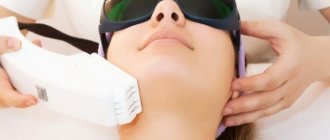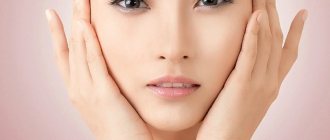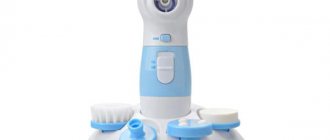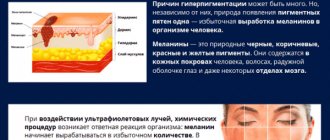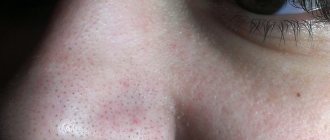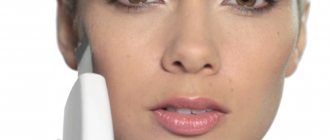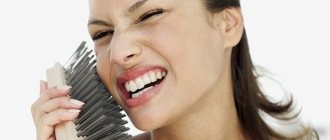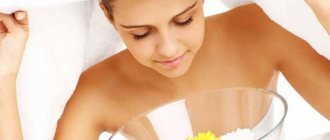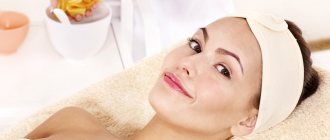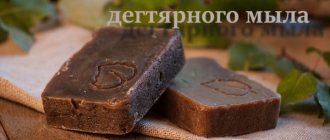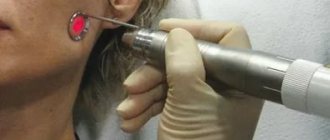Any exfoliation activates the natural regeneration process, promotes the production of collagen fibers, normalizes blood circulation and fills dermal cells with necessary oxygen.
But do not forget that after cleansing the face is exposed to the negative effects of external factors, so it is important to follow the recommendations for caring for the epidermis during the recovery period. Ignoring advice on skin regeneration can lead to side effects and deterioration of the original condition of the dermis.
What not to do after cleaning
When caring for facial skin after cleansing at home or in a salon, the following is prohibited:
- Wash your face with warm water for 24 hours - such a procedure will provoke the production of subcutaneous sebum and can cause clogged pores. You should also minimize contact of the epidermis with your hands - this increases the risk of infection in the deep layers of the skin and, as a result, contributes to the appearance of ulcers.
- During the first few days you will be outside for a long time - sudden changes in temperature, excessive humidity or exposure to ultraviolet rays can lead to severe peeling and the appearance of dark spots.
- Go to a bathhouse, sauna or gym for 7–14 days - increased sweating can lead to the spread of infection through the skin.
- Swimming in open water or a pool for several weeks - contact with water often causes the introduction of harmful microorganisms into the affected skin.
- Apply makeup for 3-5 days after cleansing your face - using foundation and other decorative cosmetics can lead to clogged pores and the appearance of sebaceous plugs.
- Use scrubbing compounds for 5-10 days - this will cause severe redness, peeling and the appearance of wounds.
- When washing your face, use soap - this will lead to severe peeling and a feeling of tightness.
- Removing crusts from the face on your own will increase the duration of rehabilitation and lead to the appearance of scars.
The question that many people are interested in is whether it is possible to drink alcohol after exfoliation, one can safely answer no, since alcoholic drinks contribute to the appearance of swelling and dry out the skin.
In addition, it is recommended to exclude sweets, smoked and spicy foods from the diet, as they increase the rehabilitation process. Before the end of the recovery period, you should not tattoo your lips or eyebrows, so as not to aggravate the condition of the skin.
What should be included in soothing masks?
The most important component of a mask that helps remove redness on the face at home is an antiseptic. More often it is a product of natural origin. In addition to antiseptics, face masks for redness include ingredients that help achieve a comprehensive effect.
The most popular components:
- cucumber – contains folic acid, which has an anti-inflammatory effect, eliminates redness, acne, and also rejuvenates and fights hyperpigmentation;
- decoctions of chamomile, calendula, string, St. John's wort are natural antiseptics, refreshing, rejuvenating. Marigolds are recommended for caring for dry skin, while string is more suitable for oily skin.
- potatoes - raw or boiled, softens, restores, whitens, eliminates redness;
- sour cream, kefir, yogurt - soothe the skin, can be used as a one-component brightening, moisturizing face mask;
- basic cosmetic oils, such as castor, olive, peach, shea - they are best used in mixtures due to their comedogenicity, as well as esters of sandalwood, tea tree, mint, rose, neroli, candea - used in diluted form to avoid burns;
- green apples – prevent the development of the inflammatory process, remove excess fat, whiten;
- aloe juice – relieves irritation, tones, accelerates the healing of microdamages;
- oatmeal – moisturizes dry skin, eliminates flaking, acne, and oily shine.
First of all, these are herbs: chamomile, plantain, aloe, St. John's wort, calendula, celandine and others. Effective oils: tea tree, rose petals, thyme and others.
Be sure to try laser facial rejuvenation and an anti-inflammatory remedy made from yogurt and tea tree oil. For 2 tables. spoons of dairy product contains 5-6 drops of healing oil. For application use a brush. After washing off the mask, it is useful to apply herbal cream.
Care after facial cleansing
Tips for caring for your face after cleansing at home or with a cosmetologist:
- Throughout the entire recovery period, you should treat your face with delicate nourishing products. Mixtures containing alcohol can be applied locally to inflamed areas.
- To relieve inflammation, the skin should be rinsed with decoctions of chamomile, plantain, calendula or St. John's wort. Herbal compresses will also help relieve irritation and swelling in a short time.
- 1-3 days after exfoliation, wash with melt or mineral water - this will help reduce the risk of spreading the infection. Adding two drops of lemon juice or apple cider vinegar to high-quality water will help even out your complexion and activate regeneration processes at the cellular level.
- For a speedy recovery, you need to apply a cream selected daily, taking into account the type of dermis, to your face, which has a nourishing and moisturizing effect. Before going outside, you should use a product with a high level of protection against ultraviolet rays - this will prevent the appearance of peeling and age spots.
2-3 days after cleansing, mesotherapy or biorevitalization is allowed, provided that there is no inflammation on the cleansed skin. Additional peelings to tighten pores, eliminate greasy shine and various rashes can be done no earlier than a week after exfoliation.
After salon cleansing, the cosmetologist treats the epidermis with a soothing mask, which helps to quickly get rid of redness after cleansing the facial skin, and selects an individual course of care for the recovery period, depending on the type of cleansing.
After mechanical cleaning
Manual exfoliation is the most traumatic technique; after it, in addition to the general rules for caring for the epidermis, it is recommended to adhere to specific recommendations:
- treat the dermis with mild agents with an antiseptic effect;
- remove excess subcutaneous fat with natural tonics without alcohol;
- When new rashes appear, apply Metrogyl gel to them 2 times a day.
You can use medications only if complications occur and only after consulting a specialist.
After vacuum cleaning
After cleansing with a vacuum, you should treat your face daily with products with a moisturizing, soothing and nourishing effect - this will help get rid of puffiness and red spots. If bruises appear after the procedure, a cosmetologist should choose a method for eliminating them.
After ultrasonic cleaning
After ultrasonic exfoliation, you need to make masks with cosmetic clay selected for the type of dermis and seaweed once every 3 days throughout the entire rehabilitation period - this will help moisturize the skin and saturate it with useful microelements. It is necessary to use sunscreen for 3-4 weeks.
After laser cleaning
After laser peeling, you should not wash your face for 4–6 days; during this period, only alcohol-free toners can be used to remove impurities. It is necessary to avoid scrubbing agents for a month so as not to damage the healthy layers of the epidermis.
At home, a few days after cleansing, it is recommended to use the following natural healing masks:
- Bodyaga - helps get rid of bruises and minor hematomas. The product is applied to problem areas and removed with warm water after 5–15 minutes. Not recommended for use by those with dry skin.
- Egg-lemon. Mix egg white and a few drops of lemon juice and apply to skin - helps even out skin tone and tighten pores.
- Cucumber. Rinse your face with warm water and apply the vegetable slices to your face, leave for 30–50 minutes. The mask helps saturate the dermis with essential microelements, eliminates swelling and redness.
- Sour cream. Rub sour cream into the skin along massage lines, rinse after 30–40 minutes. The product helps get rid of flaking.
Masks are allowed to be used no more than 2 times a week. Before the first application, you should do an allergy test - for this, a small amount of the prepared mixture is distributed on the bend of the elbow and left for 15-25 minutes. If during this period of time there is no strong burning sensation, feeling of tightness, itching and severe redness, you can use the mixture for its intended purpose.
Care at home. Mask recipes
For additional care and to speed up the healing process, you can make face masks. It must be remembered that they must be clean, not cause allergies, and they should be washed off with warm, purified water. So, home care after facial cleansing may be as follows.
Take clay, which is recommended to be purchased at the pharmacy, add a little grated raw potato and lemon juice. Apply the mask for ten to fifteen minutes and wash off. It is important to perform this action one day after the cleansing procedure. The mask will help soothe the skin, relieve irritation, and lemon juice will restore the acid-base balance of the skin.
Apple fruit puree can be an excellent nutritious vitamin mask. You just need to grate one apple on a fine grater and apply the resulting mass to the skin for twenty minutes. You can first cool the apple in the refrigerator for a few minutes. This manipulation will have a calming effect and nourish the skin with vitamins. An egg white mask helps a lot. You need to mix it with a few drops of lemon juice and apply it to the skin. This composition helps to narrow pores.
Complications
Possible complications after cleaning:
- The appearance of red spots, bruises or bruises is a consequence of excessive intensity of the procedure or too thin skin.
- Rashes should not be squeezed out so as not to provoke the spread of infection. Acne should be wiped with chlorhexidine or Baneocin.
- Inflamed acne appears due to the removal of ulcers during cleansing or improper rehabilitation care. To eliminate them, it is necessary to use antibacterial ointments.
- Peeling occurs due to the removal of the stratum corneum of the dermis. To get rid of it as quickly as possible, you need to use delicate moisturizers.
- Swelling often appears after acne removal and can last from 2 to 7 days.
With proper skin care after cleansing, the above side effects disappear on their own within a week. If during this time the appearance and condition of the skin has not improved, you should be examined by a doctor.
In the case of exfoliation of skin with the presence of ulcers, there is a risk of infection spreading, which leads to aggravation of the inflammatory process. The appearance of new ulcers may be accompanied by an increase in body temperature - in this case, it is necessary to undergo an examination by a doctor and take a course of antibiotics.
Self-removal of inflamed rashes can cause post-acne, scars and dark spots. After complete restoration of the dermis, you can get rid of such side effects using mesotherapy or physiotherapy.
Failure to follow the rules for caring for cleansed epidermis can cause clogged pores and the appearance of blackheads. Repeated exfoliation will help solve this problem.
Masks after peeling at home
There are many recipes for preparing masks for redness on the skin, using available products. If you feel any unpleasant sensation while using the mask, you should immediately wash it off your face and apply a soothing cream.
Here are the most popular and effective recipes for skin redness.
- 2 table. l. dried mint, filled with 2 tbsp. boiling water, cook over low heat for 10 minutes.
- Strain the broth, cool and add 2 tablespoons. l. tinctures of calendula and boric alcohol.
- Wipe the red areas with this product every half hour, the results will appear throughout the day.
- Soften low-fat cottage cheese with milk and mix it in a blender with an equal amount of peeled cucumber.
- This mask is applied for 15-20 minutes. on the face.
- This mask relieves redness and whitens.
- Mix juice from medium-sized carrots with an equal amount of cottage cheese and 1 table. l. olive oil.
- Apply to face for 15 minutes, then rinse.
- The effect of use is good whitening and softening of the skin.
Potato mask
Raw grated potatoes are applied to the skin of the face. The effect of application is to relieve redness well.
In fact, each recipe is good and useful in its own way, but when choosing, you should focus on your skin type and specific problems that bother you. It is also important that the composition of the mask really suits you. Change and alternate the recipes you use from time to time.
An anti-redness mask will help relieve puffiness after cleansing, as well as get rid of strong beauty. To prepare it, you need to mix a tablespoon of sour cream, homemade yogurt and kefir and carefully treat all inflamed areas with the mixture. A mask made from kefir and raw potatoes also effectively removes redness: grate the root vegetable and take a tablespoon of its pulp, dilute it to a smooth paste (kefir can be replaced with yogurt).
If the skin is very dry, flaky and itchy, then try crushing and brewing oatmeal so that it swells well (you can soak the oatmeal immediately in warm kefir or milk in a ratio of 2:3). The softened mass will immediately transform your skin. And if you add a little more honey, this mask will remove traces of pimples and acne, have an antibacterial effect, nourish the skin and reduce its hypersensitivity.
Mask after cleansing
After cleansing, it is not recommended to immediately make masks with fruit or vegetable pulp, as they contain acids that can irritate the skin even more.
A soothing mask after peeling should be aimed at neutralizing inflammatory processes, and also, if necessary, have an antibacterial effect. When the consequences of cleaning are particularly pronounced, cosmetologists sometimes even advise the use of antiseptics.
Mix two tbsp. l. white cosmetic clay with the same amount of talc and one tbsp. l. chloramphenicol powder (crush tablets). To dilute the composition, take 3% peroxide. Another recipe - one tbsp. l. dilute the powder from four aspirin tablets with water (you can dissolve them), add a teaspoon of liquid honey or vegetable oil (jojoba, grape seeds) to the mixture.
Herbal mask
A herbal mask will soothe the skin and relieve irritation. Brew the decoction - pour boiling water and briefly simmer the mixture of dry herbs plantain, mint and chamomile (one tablespoon per half liter). Leave to brew for half an hour, then strain and add one teaspoon to the liquid. starch. A herbal mask made from plantain and nettle leaves will also have an excellent antiseptic effect (rinse them and grind them into a paste), add lemon juice to the mixture. This will help you cope with any inflammation.
We invite you to read Diet for skin melanoma. Survival prognosis for stage 1 melanoma
Chamomile mask
Chamomile itself can be used effectively separately, and if you combine chamomile infusion with pink clay (dilute one tablespoon of clay powder) and sour cream (tsp), you can get rid of red spots and severe irritation.
Soda tonic
Regular soda will cope with inflammation - just dissolve a teaspoon of soda in a glass of water and wipe your skin with this solution.
Honey and oil
Liquid honey mixed with yolk and sunflower oil can moisturize dry skin and soften its rough areas (the mixture must be beaten and applied in a thick layer). And honey in combination with cottage cheese (1:1) will remove rashes, peeling, inflammation and irritation.
Green tea
Green tea will soothe irritated skin and cure acne. Brew strong green tea, let it cool, and then soak cotton pads in the liquid and apply them to the inflamed areas.
Mask with fruits
To prepare the mask, wash and peel fruits or vegetables and mash them into a puree. To enhance the effect, you can add fermented milk products, yolk, and vegetable oils to the pulp.
When choosing fruits and vegetables for a mask, remember that not all are suitable for a soothing composition: cucumber pulp or parsley have an excellent tonic and whitening effect, peaches will smooth the skin and heal sensitive skin, pears and apples will improve complexion and remove age spots , will give the dermis a fresh and healthy look, bananas will deeply moisturize and rejuvenate the skin, grapes will promote renewal and restoration. In addition, they are all simply a storehouse of vitamins and nutrients.
Yeast for skin
The yeast in the mask will rejuvenate and soothe the skin - to dilute the yeast (take ten grams), use warm yogurt or kefir. You can add a teaspoon of linden decoction or strawberry juice to the mixture.
Thanks to the effective effects of masks, your skin will not only get rid of irritation and increased sensitivity, but will also recover faster, which means it will be able to maintain youth and beauty for a long time.
Do you use soothing skin masks at home? Please share your experience and favorite recipes in the comments.
Alginate mask is a professional product based on alginic acid and its salts. This component is obtained only from brown algae - it is not found anywhere else. Alginate masks, or “alginates,” as cosmetologists often call them, turn into a film on the skin through which neither air nor moisture passes. Thanks to this, they “lock” moisture and beneficial components into the skin.
The charming, well-groomed woman has both salon procedures and her own methods and recipes for caring for her facial health. The preparations used by a professional cosmetologist have a powerful effect and take into account the general characteristics of skin types and possible problems. Light, harmoniously balanced home remedies include repeatedly tested, personally selected natural ingredients.
Side effects of the procedure
After most types of cleansing, a number of side effects are observed on renewed facial skin:
- Rashes. Inflamed pimples appear due to infection.
- Red spots mean that during cleansing the surface vessels were damaged or the water balance in the skin was disturbed.
- Small wounds most often appear after mechanical peeling at the sites of comedones.
- Peeling occurs due to the removal of the dead layer of the dermis.
- Burns appear after laser exfoliation due to an incorrect procedure or individual characteristics of the body.
- Bruising may occur after vacuum or manual peeling due to capillaries located close to the surface layer of the skin.
After any cleaning, redness is observed - this is a normal reaction of the body and the side effect will go away on its own in a few days.
Possible causes of redness on the skin of the face
The cause of such a problem may be hidden in disturbances in the functioning of the gastrointestinal tract or in the body’s rejection of any substances supplied with food, or may be associated with the activity of the nervous system. Therefore, first of all, it is necessary to find out the cause, and if the reason lies on the surface, take appropriate measures, but if you cannot identify it yourself, you need to undergo a medical examination.
In addition to diseases and exposure to external factors, some internal, but relatively easily remediable causes also have an undesirable effect on the skin of the face.
Namely:
- Staying under stress for a long time;
- Alcohol abuse;
- Frequent consumption of spicy foods;
- Using cosmetics that are not suitable specifically for your skin.
